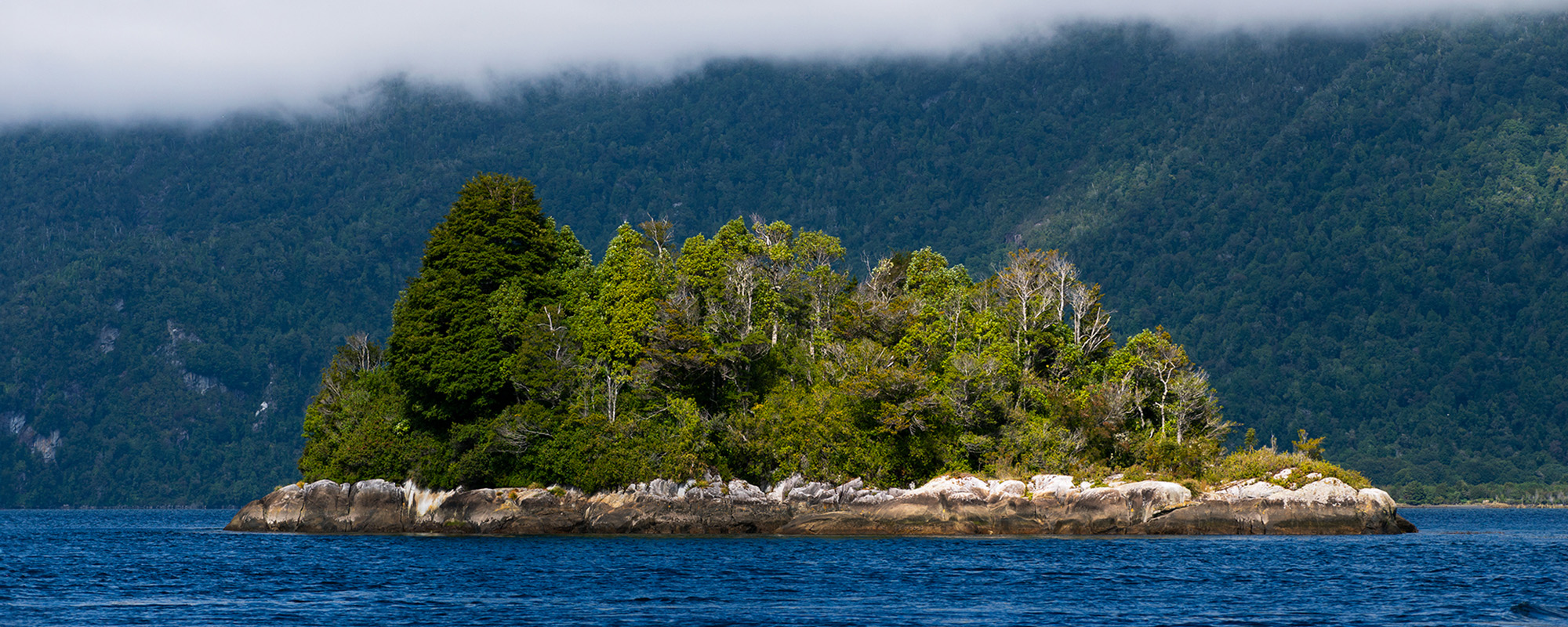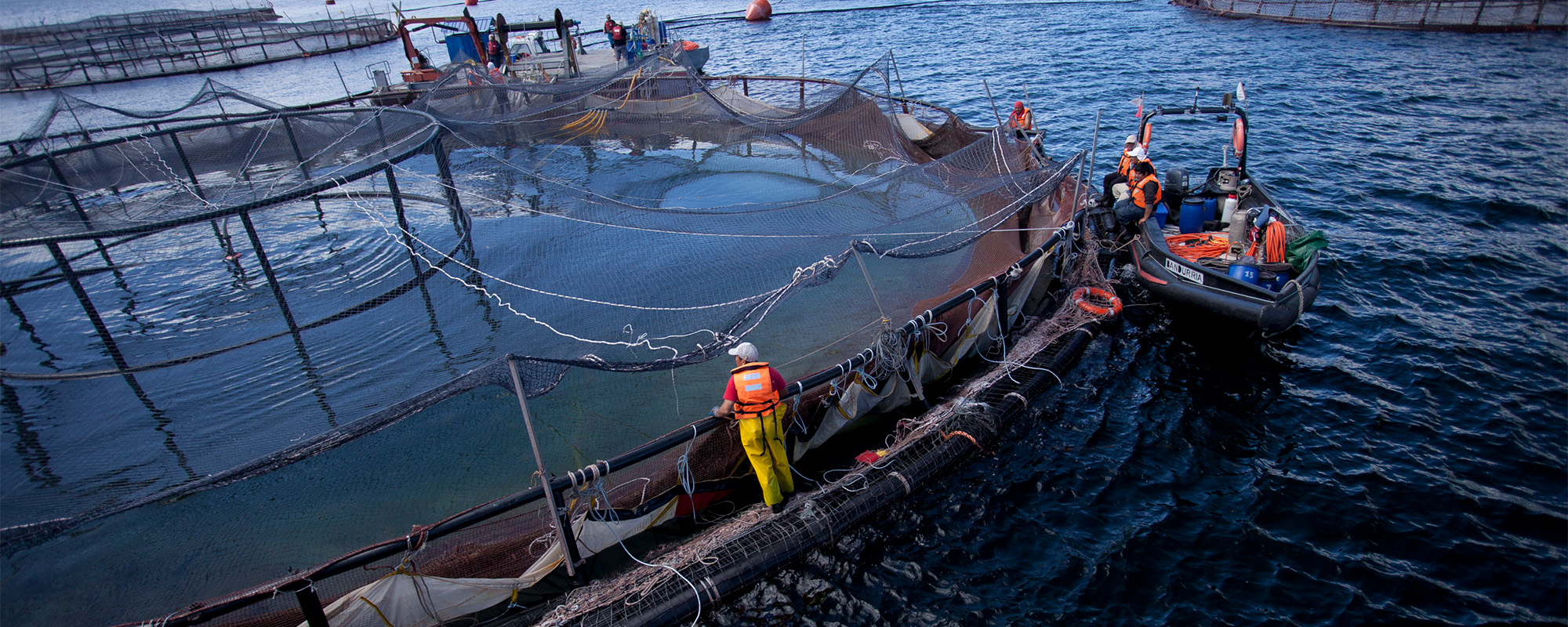
Photo: Eduardo Sorensen
The impact of industry on ecosystems
There are more than 400 aquaculture concessions granted within protected areas in Patagonia. This figure represents 29% of the total existing concessions in Chile.
Since it is the cultivation of exotic and carnivorous species, with an intensive production system
, it requires artificial food supply, therapeutic treatments, use of disinfectants, infrastructure for the development of the cage ponds, among
others, generating diverse environmental impacts.
Use of antibiotics
Salmon are affected by diseases in both fresh and salt water, which are easily transmitted among them, due to the anoxia (lack of oxygen) of their waters and the overcrowding in which they are found. Salmon diseases include bacterial kidney disease (BKD), piscirickettsiosis (SRS), rainbow trout fry syndrome (RTFS), and infectious pancreatic neocrosis (IPN).
Antibiotics to attack bacterial diseases are mainly applied by two methods: with medicated food or by injections.
One of the serious consequences of the medication in food is that, when not consumed by the salmon, it becomes part of the diet of native fish living near the cages, altering the food chain, the health of the ecosystem, generating bacterial resistance, among other potential impacts.
This implies that, in general, it impacts marine ecosystems because they contaminate the waters and permeate the different species surrounding the cultivation centers. There is no effective control or guarantee that the native species surrounding them do not ingest these antibiotics deposited on the bottom, such as those scattered by marine currents.
Contamination from the use of chemical products
In addition to antibiotics, the industry uses a large number of other chemical products, including disinfectants, antifoulants and drugs such as anesthetics, antiparasitics and vaccines. From the use of these chemicals, some pose health and environmental risks due to the methods of administration and frequency applied by the industry, such as disinfectants, antifoulants and antiparasitics.
The presence of these chemicals generates unintentional damage and consumption for the species that inhabit these ecosystems, as it impacts their life cycle, can cause loss of biodiversity, changes in microbial communities and other potential damage.
Escape of salmon
Salmon are exotic species and severely alter native ecosystems because they directly prey on native freshwater and saltwater fauna, such as stonefish, silversides, puyes, and mote, among others. In addition, they compete for food with native species that have similar prey, such as snook, stonefish, huaica, icefish, farolito, rollizo, and blanquillo.
Between 2010 and 2020, there were a total of 69 reported escapes, with 40 events in the Los Lagos region, 26 in Aysén and 3 in Magallanes. This means that the total number of fish escaped was close to 5 million fish, of which only a little more than 600 thousand were recaptured.
Currently, the General Law of Fisheries and Aquaculture indicates that after an escape, salmon farming companies will be sanctioned with a fine equivalent to the harvest value of the amount of fish escaped, recaptured, and the history of massive escapes of the farming center. However, if there is no self-reporting by the industry, there is very little or no control and verification of these events.
Industrial waste
The salmon industry uses infrastructure with nets, plastic bags, ropes and buoys, which when left in disuse become garbage and a danger that affects native species, particularly animals such as birds, fish and marine mammals, as well as deteriorating the landscape.
Plastic pollution occurs because the industry does not take care of the garbage, leaving them abandoned. This becomes a threat to hundreds of species such as marine mammals, birds, fish, among others.
The disintegration of plastics produces microplastics that, imperceptible, are transported by the wind and marine currents. These, in turn, are also ingested and/or absorbed by the local fauna, causing damage to the digestive system.
On the other hand, there is also another type of solid waste submerged and abandoned in the seabed, which alters the environment and the species that inhabit it. This is part of the infrastructure or work materials such as chains, ladders, concrete structures for the installation of cage rafts (known as dead bodies), wheelbarrows and steel cables, among others.
Enameling of marine mammals
The presence of the salmon industry with its cage rafts and the infrastructure used in its facilities causes dolphins, whales, sea lions and other species to become easily entangled in the nets and ropes.
Especially the Chilean dolphin, an endemic species (also known as the black dolphin), is the main threat to the salmon industry due to the high rates of entanglement and death of this species reported with salmon farming facilities. SERNAPESCA has received several complaints with evidence of this problem.
Collisions with whales
Problems due to collisions with whales are part of the scenario. From Chiloé to the south there is a real nautical highway where all kinds of boats and motors move, mostly from the salmon industry, which generates frequent collisions with marine mammals and even several individuals have stranded as a result of the deadly impact.
A study identified areas of overlap between the presence of blue whales, salmon farming concessions and the high density of maritime traffic, where it is possible to observe the complexity for this endangered species.
Fecas
The accumulation of feces and undigested food on the seafloor is high due to the number of confined salmon living in the cages of sea farming centers. This situation strongly impacts the species and biological communities associated with the seafloor, as well as the composition and abundance of plankton in the water column. In addition, the accumulation of feces increases the demand for oxygen in coastal ecosystems, affecting the survival of other species. The dispersion of feces from a cage raft extends tens to hundreds of meters, carried by marine currents.
The feces and undigested food, when deposited on the seabed, generates a crust or layer in which anoxia is produced. In Chile, the generation of sludge reaches 1.4 tons for each ton of salmon produced, consisting mainly of organic waste, such as excreta and uneaten food.
Dead zones
The salmon industry's cage raft operation is producing "anoxic zones" or areas with an absence of oxygen on the seabed, as a result of the accumulation of organic matter that prevents the normal development of benthic life (species that live associated with the seabed).
In these areas, the presence of whitish-colored bacteria is common, indicating contamination due to a high concentration of organic matter, affecting biodiversity as a whole.
This decomposing organic matter generates greenhouse gases such as methane, impacting the ability of the Patagonian fjords to sequester carbon, a key role in mitigating global warming.
Harmful algal blooms (HABs)
Harmful algal blooms (HAB) are a natural situation associated with the abundance of nutrients, mainly phosphorus and nitrogen in the water column. They occur under certain climatic conditions, such as increased temperature, which facilitates their proliferation. Salmon farming contributes to or increases the organic load (phosphorus and nitrogen) in ecosystems and can therefore contribute to more intense HABs.
HAB episodes have meant the mortality of thousands of salmon, the most prominent case being the episode that occurred in 2016.
HABs are caused by different species that inhabit phytoplankton (diatoms and dinoflagellates), which cause red tides and/or brown tides. In general, red tides cause toxicity problems in mollusks, while brown tides can affect fish, such as salmonids.
Fish silage and transport
Salmonid culture (Atlantic salmon, trout and Coho) has a freshwater and a seawater culture phase. Juvenile salmon from freshwater culture are introduced into seawater culture centers for fattening and, depending on the species and the conditions of the site, this phase can last between 8 to 18 or 19 months.
During the fattening stage, mortality occurs in a percentage of the fish being cultured. It is estimated that this mortality is 10 to 11% of the number of fish entering or being planted in culture centers for fattening. According to current regulations, there is a General Sanitary Program for Mortality Management, which establishes that dead fish must be removed daily, ground and formic acid is added to them in order to maintain a pH less than or equal to 4, forming a homogeneous mixture that is stored in containers. This procedure is called silage. These containers are periodically transported to the fishmeal processing plants.
Although regulations require the timely removal of dead salmon, there may be situations in which a portion of this mortality remains on the seafloor, decomposing and increasing the organic matter load.
Visual impact
Patagonia is known for its tourist attraction, which includes its scenic beauty and unrepeatable nature in the southern hemisphere. Visual pollution from salmon farms negatively affects the experience of tourists seeking a unique natural environment.
In addition, it is common to see on the coast crop centers abandoned for years, real environmental liabilities that, beyond abandonment, continue to produce scenic pollution. This generates damage to the landscape, violating its beauty and harming its essential value. Patagonia cannot be caged.
Related news
[Campaña] Del dirigente ambientalista Peter Hartmann Samhaber: Liberan completo informe sobre el impacto ambiental de 30 años de salmoneras en áreas protegidas de Aysén
Por: Patricio Segura El objetivo es “dar a conocer, transparentar y evaluar la ubicación e impactos de las concesiones salmoneras en las áreas protegidas de la región de Aysén, considerando aspectos ambientales y normativos”; “identificar y analizar la distribución,...
[Follow the Money] The fish you are buying may not be as sustainable as you think.
By: Rémy Käller (Read story on Follow the Money) Consumers who look for a "sustainable" label when buying salmon in European supermarkets may believe they are paying a higher price to protect the environment. But the fish that...
[ElDesconcierto] Even Patagonia brand accuses salmon companies of leaving "dead zones" in protected seas of southern Chile
Por María del Mar Parra (Leer noticia en ElDesconcierto) Más de 400 salmoneras operan en Parques y Reservas Nacionales de la Patagonia, incumpliendo en cientos de ocasiones las normas ambientales. Científicos del mundo usaron el caso como ejemplo de la falta de...

Photo: Daniel Casado
![[Campaña] Del dirigente ambientalista Peter Hartmann Samhaber: Liberan completo informe sobre el impacto ambiental de 30 años de salmoneras en áreas protegidas de Aysén](https://www.salvemoslapatagonia.cl/web/wp-content/uploads/2024/12/tc_archive_acuicultura_dsc3235-400x250.jpg)
![[Follow the Money] The fish you are buying may not be as sustainable as you think.](https://www.salvemoslapatagonia.cl/web/wp-content/uploads/2024/11/2_kopie-400x250.webp)
![[ElDesconcierto] Even Patagonia brand accuses salmon companies of leaving "dead zones" in protected seas of southern Chile](https://www.salvemoslapatagonia.cl/web/wp-content/uploads/2024/11/7030-salmoneras-400x250.jpg)